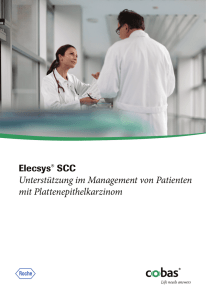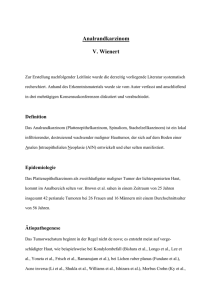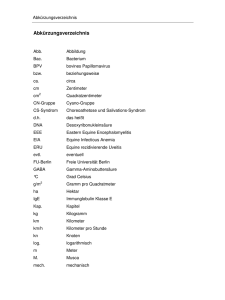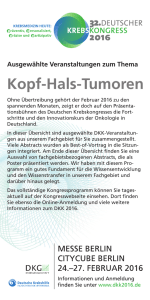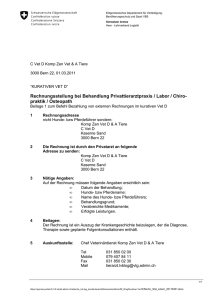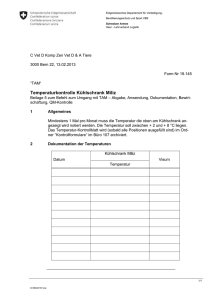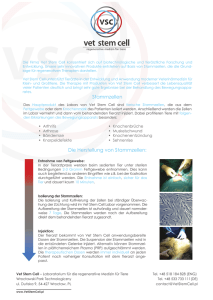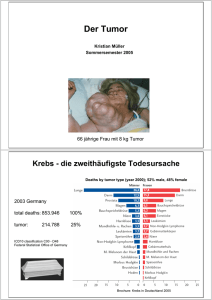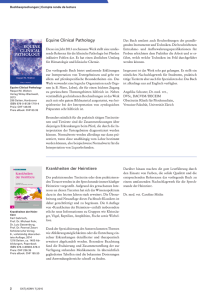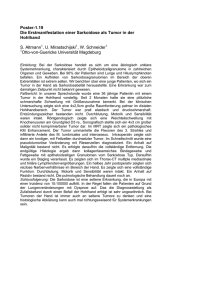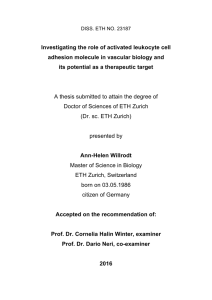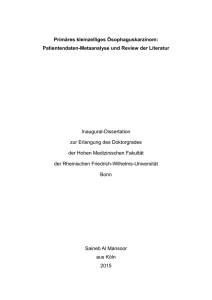Plattenepi-Textlang-DE - pferdezahn
Werbung
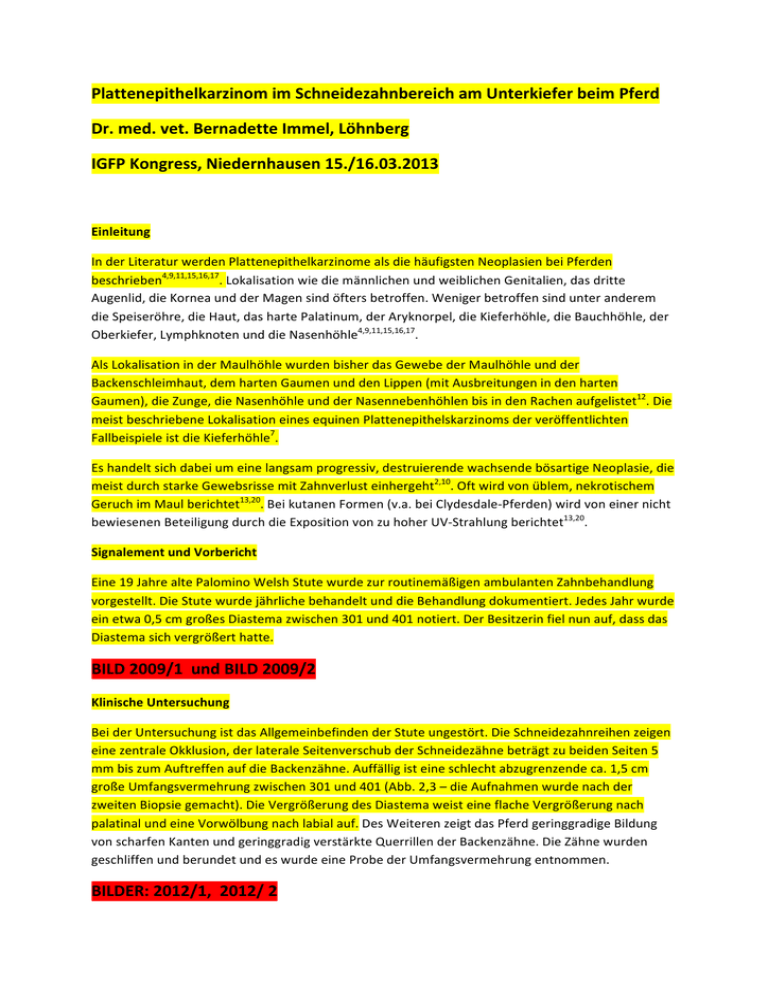
Plattenepithelkarzinom im Schneidezahnbereich am Unterkiefer beim Pferd Dr. med. vet. Bernadette Immel, Löhnberg IGFP Kongress, Niedernhausen 15./16.03.2013 Einleitung In der Literatur werden Plattenepithelkarzinome als die häufigsten Neoplasien bei Pferden beschrieben4,9,11,15,16,17. Lokalisation wie die männlichen und weiblichen Genitalien, das dritte Augenlid, die Kornea und der Magen sind öfters betroffen. Weniger betroffen sind unter anderem die Speiseröhre, die Haut, das harte Palatinum, der Aryknorpel, die Kieferhöhle, die Bauchhöhle, der Oberkiefer, Lymphknoten und die Nasenhöhle4,9,11,15,16,17. Als Lokalisation in der Maulhöhle wurden bisher das Gewebe der Maulhöhle und der Backenschleimhaut, dem harten Gaumen und den Lippen (mit Ausbreitungen in den harten Gaumen), die Zunge, die Nasenhöhle und der Nasennebenhöhlen bis in den Rachen aufgelistet12. Die meist beschriebene Lokalisation eines equinen Plattenepithelskarzinoms der veröffentlichten Fallbeispiele ist die Kieferhöhle7. Es handelt sich dabei um eine langsam progressiv, destruierende wachsende bösartige Neoplasie, die meist durch starke Gewebsrisse mit Zahnverlust einhergeht2,10. Oft wird von üblem, nekrotischem Geruch im Maul berichtet13,20. Bei kutanen Formen (v.a. bei Clydesdale-­‐Pferden) wird von einer nicht bewiesenen Beteiligung durch die Exposition von zu hoher UV-­‐Strahlung berichtet13,20. Signalement und Vorbericht Eine 19 Jahre alte Palomino Welsh Stute wurde zur routinemäßigen ambulanten Zahnbehandlung vorgestellt. Die Stute wurde jährliche behandelt und die Behandlung dokumentiert. Jedes Jahr wurde ein etwa 0,5 cm großes Diastema zwischen 301 und 401 notiert. Der Besitzerin fiel nun auf, dass das Diastema sich vergrößert hatte. BILD 2009/1 und BILD 2009/2 Klinische Untersuchung Bei der Untersuchung ist das Allgemeinbefinden der Stute ungestört. Die Schneidezahnreihen zeigen eine zentrale Okklusion, der laterale Seitenverschub der Schneidezähne beträgt zu beiden Seiten 5 mm bis zum Auftreffen auf die Backenzähne. Auffällig ist eine schlecht abzugrenzende ca. 1,5 cm große Umfangsvermehrung zwischen 301 und 401 (Abb. 2,3 – die Aufnahmen wurde nach der zweiten Biopsie gemacht). Die Vergrößerung des Diastema weist eine flache Vergrößerung nach palatinal und eine Vorwölbung nach labial auf. Des Weiteren zeigt das Pferd geringgradige Bildung von scharfen Kanten und geringgradig verstärkte Querrillen der Backenzähne. Die Zähne wurden geschliffen und berundet und es wurde eine Probe der Umfangsvermehrung entnommen. BILDER: 2012/1, 2012/ 2 Differentialdiagnose Generell sollten differentialdiagnostisch alle anderen Neoplasien und chronische, entzündliche Prozesse der Maulhöhle ausgeschlossen werden. Weiterführende Untersuchung Histo-­‐Pathologische Untersuchung Es wurde im Abstand von etwa 14 Tagen zwei aufeinanderfolgenden Biopsien entnommen und von zwei unterschiedlichen Laboren untersucht. Bei der ersten Untersuchung wurden zwei 0,7 g schwere, max. kürbiskerngroße, mit weißer Schleimhaut bedeckte Gewebsstücke untersucht. Die entnommene Gingiva zeigte eine homogene Struktur. Das histologische Präparat wies eine Durchsetzung des kollagenen Stützgerüstes mit massenhaft schmäleren und breiteren Strängen unscharf begrenzter, ziemlich großer Zellen mit erheblicher Anisonukleose und Kernpolymorphie sowie deutlichen Nukleoli, eingelagerte Mitosen und im Zentrum der Stränge unterschiedlich stark ausgeprägte Verhornung auf. Im Interstitium befanden sich vielfältige Entzündungszellen. Diese Veränderungen wurden als Anteile eines verhornenden Plattenepithelkarzinoms der Mundschleimhaut beurteilt3. Bei der zweiten Untersuchung wurden vier Proben von 7 x 6 x 2 mm bis zu 11 x 7 x 4 mm eingeschickt. Färbung: Hämatoxilin. Es handelt sich um Gewebe der Maulschleimhaut. Die histologische Untersuchung ergab in allen Proben ein vergleichbares Bild: Es liegt vorgewölbte Mukosa vor, welche abschnittsweise umfangreich ulzeriert ist. Innerhalb der Mukosa proliferieren rundliche Zellen mit breitem Zytoplasmasaum und variabler Morphologie. Sie bilden kleine Inseln und Nester, in welchen sie irreguläre, plattenepitheliale Differenzierungen aufweisen. Die Zellkerne sind groß und rundlich, teils mit mehreren Kernkörperchen und breitem Zytoplasmasaum. Sie liegen dicht, infiltrieren bis in die Submukosa hinein und sind eingebettet in ein dichtes kollagenes Stroma. Es liegt eine lymphoplasmazelluläre Begleitreaktion vor. Im Bereich des ulzerierten Epithels lässt sich zusätzlich eine gerichtete, granulierende Reaktion mit Neovaskularisation und Fibrose vorweisen. Es sind Teilexstirpate zur Untersuchung eingesandt worden. Diagnostiziert wurde ein Plattenepithelkarzinom. Die Dignität wurde als maligne eingestuft und die Prognose als vorsichtig beurteilt. Es handelt sich um eine langsam wachsende, lokal aggressive Neoplasie; eine Metastasierung in die lokalen Lymphknoten kann nicht gänzlich ausgeschlossen werden8. BILD HISTO 40x und BILD HISTO 100x Es handelt sich um einen bösartigen, vom Deckepithel ausgehenden Tumor, der sowohl rezidivieren, als auch metastasieren kann. Röntgenologische Untersuchung Die Übersichtsaufnahme (0°, -­‐45°) der Unterkiefer Schneidezähne zeigen einen deutlich erweiterten Spalt zwischen 301 und 401 mit herabgesetzter Knochendichte. RÖNTGENBILD Computer tomographische Untersuchung Die Computertomographische Untersuchung zeigen sowohl eine hypodense Knochenstruktur zwischen 301 und 401 im Axialschnitt als auch eingezogene Knochenkontur im Coronarschnitt. CT BILD 1 u 2 Therapiemöglichkeiten Zu den verschiedenen Therapiemöglichkeiten gehören unter anderem die chirurgische Entfernung, die Bestrahlung, eine Verabreichung von Cisplatin und eine mögliche lokale Behandlung mit 5% Fluorouracilsalbe. Chirurgische Entfernung Je nach Größe und Lage des Tumors ist eine chirurgische Entfernung das Mittel der Wahl. Der Eingriff kann sehr schwierig sein und die Rezidivwahrscheinlichkeit ist hoch. Eine ausgedehnte Entfernung des Karzinoms mit einem Sicherheitsabstand von 1 cm, u.a. eine mögliche Hemimandibulektomie, würde den Zustand verbessern, ihn dennoch zu starken, eventuell untragbaren, funktionalen und kosmetischen Veränderungen führen10. Bestrahlung In der Literatur werden zwei Verfahren beschrieben, die gute therapeutische Erfolge erzielen. Zum einen sind dies die ϒ-­‐strahlung und zum anderen die interstitielle Iridium-­‐192-­‐Brachytherapie mit linearen, platinbeschichteten Drähten10. Verabreichung von Cisplatin Intratumorale Cisplatin Injektionen in öliger Emulsion wurden als effizient beschrieben. Die Behandlung wird mit einem zweiwöchigen Abstand, mit einer Dosierung von 1 mg Cisplatin/cm3 Gewebe intratumoral, gestartet. Beim Menschen werden als Nebenwirkungen hochgradige Übelkeit, Erbrechen, Knochenmarkssuppression und nephro-­‐, oto-­‐ und neurotoxische Nebenwirkungen beschrieben2. 5% Fluorouracilsalbe In einer Studie wurden drei Pferde mit einer Hautneoplasie mit 5% Fluorouracilsalbe behandelt. Die Salbe wird gewöhnlich über einen Zeitraum von bis zu einem Monat aufgetragen. Auch wenn die drei Fälle exzellente kosmetische Resultate erzielten, so wurden die Pferde nicht komplett geheilt. Die klinischen Anzeichen auf der Haut waren jedoch größtenteils entfernt.15 Die Therapieform mit der 5% Fluorouracilsalbe könnte jedoch eine sinnvolle Ergänzung sein, vor allem bei kleineren Läsionen an der Lippe und an der Backe13. Diskussion Die Stute, die in diesem Fall vorgestellt wird, zeigte seit Jahren ein unauffällig vorhandenes Diastema zwischen 301 und 401. Nach 6 Jahren weist sie, nun im Alter von 19 Jahren, eine Vergrößerung des Diastema auf. Die Schleimhaut ist rosa, glatt, glänzend und ohne Auflagerungen. Die weiteren Untersuchungen sind ohne besonderen Befund. Das Pferd hat ein ungestörtes Allgemeinbefinden und zeigt eine ungestörte Futteraufnahme. Eine routinemäßige Zahnbehandlung wird durchgeführt und eine Biopsie von der Umfangsvermehrung entnommen. Nach zwei pathohistologischen Untersuchungen stand die Diagnose des Plattenepithels unweigerlich fest. Aufgrund der Diagnose, der Lokalisation und des Aussehen der Umfangsvermehrung haben wir uns entschlossen diesen Fall zu veröffentlichen. Bei Plattenepithelkarzinomen handelt es sich um maligne, epitheliale verändertes Gewebe. Nun wurden weiterführende Untersuchungen vorgenommen, um eine mögliche Therapie in Angriff zu nehmen. In diesem Fall zeigt der Tumor ein langsames Wachstum und bleibt derzeit lokalisiert im Bereich der Incisivi. Das Auftragen der 5% Fluorouracilsalbe kann nicht in Erwägung gezogen, da es sich nicht um ein kutanes Plattenepithelkarzinom handelt. Die Ergebnisse nach einer Therapie von Neoplasien der Maulhöhle galten bisher eher als schwach, und die meisten Pferde mit dieser Diagnose wurden euthanasiert7,18,19. Die Prognose ist schlecht, jedoch entstehen Metastasen scheinbar langsam und Pferde können selbst im fortgeschrittenen Krankheitsstadium noch lange leben12. Die Bestrahlung wurde derzeit aufgrund der mehrmaligen therapeutischen Wiederholungen, die wochenlange Behandlung in einem weit entfernten Stall und der erheblichen Kosten nicht in Betracht gezogen. Die chirurgische Entfernung des Tumors wurde aufgrund der Tatsache, dass der komplette rostrale Teil des Unterkiefers hätte reseziert werden müssen, nicht durchgeführt. Das Entfernen von Zähnen, Alveolen und des Kieferknochens wäre in diesem Fall untragbar gewesen. Das Pferd lebt in ihrer derzeit ohne Störungen des Allgemeinbefindens und wird artgerecht gehalten. 2013/1, 2013/2 und 3 Herrn Dr. med. vet. Michael Nowak und Frau Petzoldt der Pferdeklinik Duisburg, danke ich recht herzlich für die zur Verfügung gestellten Röntgen-­‐ und CT-­‐ Bilder, die im Poster abgebildet sind. Weiterhin danke ich recht herzlich Frau Floto und Dr. Dumke der Firma IDEXX Vet Med Labor GmbH für die zur Verfügung gestellten histologischen Bilder, die im Poster abgebildet sind. Literatur und der gesamte Artikel sind im Kongressband des 12. IGFP-­‐Kongress vom 15./16.03.2014 veröffentlicht. 1. Baker, G. Equine nasal and paranasal tumours. The Veterinary Journal 1999, 157, 220–221. Article No. tvjl.1998.0345, available online at http://www.idealibrary.com on 2. Barabas K, Milner R, Lurie D, Adin C. Cisplatin: a review of toxicities and therapeutic applications. 3. Bomhard v. W, Pfleghaar Stephan. Geyer Claudia, Fachpraxis für Tierpathologie, München 1 4. Dixon PM, Head KW. Equine Equine nasal and paranasal sinus tumours: part 2: a contribution of 28 case reports. Vet J. 1999 May 15; 157 (3): 279-­‐94. PMID: 10328838 5. Dixon P.M., Tremaine W.H., Pickles Krisite, Kuhns Lorna, Hawe Carlyn, McCann Jacqui, McGorum B.C., Railton D.I. Brammer Stephanie. Equine dental disease Part 3: a long-­‐term study of 400 cases: disorders of wear, traumatic damage and idiopathic fractures, tumours and miscellaneous disorders of the cheek teeth. Equine vet. J. (2000) 32 (1) 9-­‐18 6. Granacher A. [The clinical situation. Tumor in the sublingual region associated with high-­‐ grade osteolysis in the masticatory surface of the mandible]. Tierarztl Prax. 1995 Feb; 23(1):17, 100-­‐1. German.PMID:7792769 7. Head KW, Dixon PM. Equine nasal and paranasal sinus tumours. Part 1: review of the literature and tumour classification. Vet J. 1999 May 15; 157 (3): 261-­‐78. PMID: 10328838 8. IDEXX Vet Med Labor GmbH, Floto, A, Division of IDEXX Laboratories, Ludwigsburg 9. Junge RE, Sundberg JP, Lancaster WD. Papillomas and squamous cell carcinomas of horses. J AM Vet Med Assoc. 1984 Sep 15; 185(6): 656-­‐9. PMID: 6092315 10. Knottenbelt DC, Kelly DF. Tumoren der Zähne und der Maulhöhle. In: Baker GJ, Easley J (Hrsg.) Zahnheilkunde in der Pferdepraxis. 2 Aufl. München: Elsvier 2007; 135-­‐139 11. McCaw DL, Pope ER, Payne JT, West MK, Topmson RV, Tate D. Treatment of canine oral squamous cell carcinomas with photodynamic therapy. British Journal of Cancer (2000), 82(7), 1297-­‐1299 © 2000 Cancer Research Campaign DOI: 10.1054/ bjoc.1999.1094, available online at http://www.idealibrary.com 12. Orsini JA. Nunamaker DM, Jones CJ, Acland HM. Excision of oral squamous cell carcinoma in a horse. Vet Surg. 1991 Jul-­‐Aug; 20(4):264-­‐6. PMID: 1949565 13. Paterson S. Treatment of superficial ulcerative squamous cell carcinoma in three horses with topical 5-­‐fluorouracil. Vet Rec. 1997 Dec 13; 141(24):626-­‐8. 14. Perez J, Moses E, Martin MP, Day MJ. Immunhistochemical study of the inflammatory infiltrate associated with equine squamous cell carcinoma. J Comp Pathol. 1999 Nov; 121(4): 385-­‐97 15. Schuh JC. Squamous cell carcinoma of the oral, pharyngeal and nasal mucosa in the horse. Vet Pathol. 1986 Mar; 23(2):205-­‐7. PMID: 3962089 16. Top, van den J.G.B., Heer N. de, Klein W.R., Ensink J.M., Penile and preputial squamous cell carcinoma in the horse: A retrospective study of treatment of 77 affected horses, Equine vet. J. (2008) 40 (6) 533-­‐537 doi. 10.2746/042516408X281171 17. Tremaine W.H., Dixon P.M. A long-­‐term study of 277 cases of equine sinonasal disease. Part 2: Treatments and results of treatments. Equine vet. J. (2001) 33 (3) 283-­‐289 18. Vet Comp Oncol. 2008 Mar; 6(1):1-­‐18. doi: 10.1111/j.1476-­‐5829.2007.00142.x. 19. Wohlsein P, Baumgärtner W, Odontogene Tumoren. In: Carsten Vogt (Hrsg.) Lehrbuch der Zahnheilkunde beim Pferd. Schattauer: 2011;165-­‐176 Squamous cell carcinoma in equines mandible incisors Introduction Squamous cell carcinoma (SCC) is the most frequently described neoplasm in the horse. The most affected localization are the male and female genitalia, the third eyelid, cornea and the stomach are more often affected. Less involved are oesophagus, skin, hard palatine, arytenoid cartilage, maxillary sinus, peritoneal cavity, maxilla, lymph nodes and nasal cavity4,9,11,15,16,17. The tissue of the mouth, oral mucosa, hard palate, lips (with spreading into the hard palate), nasal cavity and paranasal sinus into the pharynx were listed as localization of the mouth. In case studies the most frequently affected localization of equine SCC was encountered the maxillary sinus7. The SCC is a slowly progressive, destructed growing malignant neoplasm which is characterized by disruption of tissue and often followed by loss of teeth2,10. Many times bad, necrotic odor is reported. The involvement of UV-­‐light as a cause has been described in the cutaneous form of SCC (especially in Clyesdale horses) but not yet been proved12,20. Case A 19 year old palomino welsh mare has been introduced for a routine ambulant dentistry. She has been treated every year and her case reports are available. A diastema (size 0,5 cm) in between 310 and 401 has been documented every year. Recently the owner of the horse observed an increase of the diastema. Clinic The general condition of the horse was fine. The occlusion of the incisors was zentral, the lateral excursion till contact of the molar tables was 5 mm to both sides. There was an obviously, but bad definable 1,5 cm large tumor between 301 and 401. The extension of the diastema shows a flat lingual enlargement and a labial smelling. The horse shoes also sharp points and ATR of the cheek teeth. Dentistry has been performed and a sampling of the tumor was taken. Differential diagnosis All other neoplasia and chronic inflammatory diseases of the mouth should be differentially excluded. Continuative examinations Histological-­‐pathological examination Two samples have been taken in an interval of two weeks and two different laboratories investigated the tissue. In the first examination two (0,7 g heavy, pumpkin seed seize) pieces of tissue covered with a white mucosa were examined. The extracted gingiva showed a homogeneously structure. The histological preparation showed an assertion of the collagenous matrix with a large quantities of small and wide strands of diffuse confined , relatively big cells with a large amount of anisonucleosis and polymorphy of the nucleus, plus obvious nucleoli, stored mitosis and in the center of the strands differently strong distinctive cornification. In the interstitium were multifaceted inflammatory cells. These transformations are evaluated as portions of a keratinizing squamous cell carcinoma of the oral mucosa3. In the second examination were four samples (in between 7 x 6 x 2 mm to 11 x 7 x 4 mm) send. Stain: hematoxilyn eosin. It is oral mucosa. The histological examination gave a comparable result in every sample: there is a bulged mucosa which shows sectionally ulcerations. In the mucosa proliferate rounded cells a wide cytoplasm margin and a variable morphology. They form small islands and nests, in which they show irregular, squamous epithelial differentiations. The nucleuses are big and round, parts with several nucleoli and wide cytoplasm margin. They lay closely, infiltrate into the submucosa and are embedded into tight collagenous stroma. There exists a lymphoplasmacellular collateral reaction. The area of the ulcerative epithelia shows additionally a directed granulating reaction with neovasculation and fibrosis. For the examination were part extirpation send. A squamous cell carcinoma was diagnosed. The dignity was graded malign and the prognosis is rated as cautious. It is a slowly growing, local aggressive neoplasia; it is possible that metastases are developing in the local lymph nodes8. It is a malignant tumor, starting from the epithelia tissue, can may recurrent and metastasizing. Radiological examinations / Computed tomography examinations The overview x-­‐ray (0°, -­‐45°) of the mandible incisors shows an extended gap between 301 and 401 decreased bone density. The computed tomography examination shows both a hypodense bone structure in the axial section and a drawed in of bone contour in the coronar section. Therapeutic options The different therapeutics options include among others the surgical extirpation, radiotherapy, intralesional chemotherapy with cisplatin and a local application of 5% fluorouracil cream. Surgical extirpation The surgical excision is the treatment of choice depending on size and position of the tumor. The surgery can be difficult and the probability of recurrence is high. An extensive excision of the carcinoma with 1 cm safety distance, like a possible hemimandibulectomy , would improve the state but would most likely lead to an unbearable, functional and cosmetic change12 Radiotherapy Two procedures found in the literature reach good therapeutically results. On the one hand there has been the ϒ-­‐radiation been described and on the other hand the interstitial iridium-­‐192-­‐ brachytherapy with linear, platin coated wire.10 Cisplatin Injection of intralesional cisplatin in oily emulsion has proven efficacious in treatment. The therapy starts with a two week interval (1mg cisplatin/cm3 into the tissue). In humans numerous side-­‐effects including nephrotoxicity, severe nausea and vomiting, myelosuppression, ototoxicity and neurotoxicity are described2. 5% fluorouracil Three horses with a superficial ulcerative squamous cell carcinoma were successfully treated with topical 5-­‐fluorouracil. The cream is usually applied daily for a month. Although the three cases reached excellent cosmetic results, they didn´t produce a clinical cure. The cutaneous signs were largely eliminated15. The therapy with 5 % fluorouracil could be a useful supplement therapy when there a small cutaneous lesions on the lip or the cheek13. Discussion The mare which was introduced in this case showed for year’s non-­‐pathological diastema between 301 and 401. After 6 years, in an age of 19 years, the tissue in between the diastema started to increase. The mucosa was pink, shiny, and smooth and seemed normal. The further examinations were without any special characteristics. The horse showed normal condition. The routine dental work was done and a biopsy was taken. After two histologically examinations there diagnosis was beyond questions a squamous cell carcinoma. We published this case because of the diagnosis, the localization and the appearance of the tumor. A SCC shows malignant, epithelial changed tissue. More examinations were done to start with a possible therapy. In this case the tumor is growing slowly and stays in the localization of the incisors. The use of 5% Fluorouracilcream was not considered because this tumor is not cutaneous location. The results to cure a SCC were rather poor and the most horses were euthanized7,18,19. The prognosis is bad, but metastases are growing slowly and horses are able to live even in an advanced decline12. Radiotherapy was not being considered because of the fact that the therapy includes several repeating therapeutic treatments for weeks in a stable far away from home and the significant costs. The excision of the tumor was not being made because of the fact that the complete rostral part of the mandible has to be removed. In this case the extraction of incisors, alveolus and bone was intolerable. Right now the horse still lives in normal general conditions in a comfortable stable.
